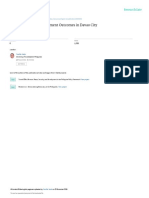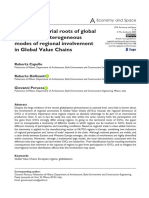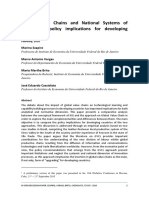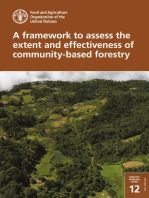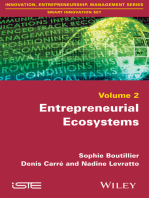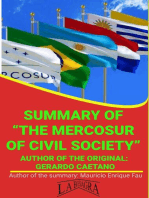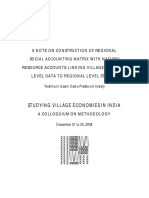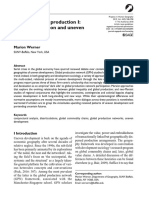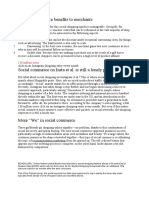Professional Documents
Culture Documents
Development and Validation of A Scale of Influence of Cotton Associations On Territorial Governance in Nampula - Mozambique
Original Title
Copyright
Available Formats
Share this document
Did you find this document useful?
Is this content inappropriate?
Report this DocumentCopyright:
Available Formats
Development and Validation of A Scale of Influence of Cotton Associations On Territorial Governance in Nampula - Mozambique
Copyright:
Available Formats
Volume 8, Issue 5, May 2023 International Journal of Innovative Science and Research Technology
ISSN No:-2456-2165
Development and Validation of a Scale of Influence
of Cotton Associations on Territorial Governance in
Nampula – Mozambique
Paulo, Hilário1
1
University of Trás-os-Montes and Alto Douro,
CETRAD, Vila Real, Portugal
Abstract:- The objective of this research was to develop I. INTRODUCTION
and validate a scale of the influence of cotton production
associations in territorial governance in the Nampula In the nineteenth century, the cotton crop was
region of Mozambique. The process was divided into two introduced in Mozambique and over the years went through
stages. In the first stage, items were produced after a different production models, as mentioned by Arlindo
broad review of the literature and electronic platforms of (2010). At present, cotton production is carried out mainly
civil society organizations, NGOs and cotton farmers' by small producers, who may or may not be organized in
associations operating in the study region. After that, associations, based on the system of concessions of areas to
these statements were submitted to a panel of experts for cotton ginning companies. These companies are responsible
content and face validity. While in the second stage, a for fostering and extending the cultivation of cotton, which
cross-sectional survey was conducted with cotton leads to a monopsony market in this subsector, as pointed
producers organized in associations of thirteen districts out by Mosca (2011)
of Nampula province in northern Mozambique, for
construct validity and reliability. A paper survey was The cotton subsector is a significant source of income
carried out on producers with the authorization of the for rural areas in Mozambique. This is reflected not only in
competent authorities. A total of 250 responses were the local economy, but also in the weight of cotton in the
country's trade balance, since it is one of the most exported
received, imported into the SPSS for data analysis. To
evaluate the construct validity, an exploratory factor agricultural products in recent decades, as pointed out by
analysis was performed, while the reliability of the Bruna (2017).
instrument was determined by Cronbach's alpha In developing countries, including Mozambique,
coefficient. The results indicated a scale of 25 items agriculture is still the foundation of the rural economy, with
structured in five dimensions, namely, district approximately 2.6 billion people directly dependent on
performance (5 items), political participation of agriculture for their livelihoods. (Gil et al., 2019). But in the
associates (5 items), impact of associationism on district current neoliberal economic model, there are market barriers
performance (5 items), productive efficiency of associates associated with price and quota instability and imbalances in
(5 items) and cotton associations as agents of territorial bargaining power, which prevent agriculture from
governance (5 items), each statement presented load contributing enough to overcome the levels of poverty that
forces greater than 0.50 and the model explained 62.71% characterize these populations (Alain & Sadoule, 2007;
of the total variance. The values of the reliability Arbolino et al., 2018). Based on theories of endogenous
coefficient for the global scale (CA = 0.827), as well as for development and social capital, it has been argued that the
both subdimensions, such as "district performance" (CA qualities associated with territorial identity, shared
= 0.949), "political participation of associates" (CA = landscape and leadership are intangible assets that could be
0.705), "impact of associationism on district mobilized to stimulate associativity and mutual
performance" (CA = 0.500), "productive efficiency of collaboration around common interests (Dale et al., 2020;
associates" (CA = 0.543) and "cotton associations as Leonard, 2019). The aspirations to quality of life and the
agents of territorial governance" (CA = 0.556) were predominant sources of wealth in each territory are the
excellent. The correlation coefficients of the retest ranged attractions that can motivate the organization of people.
from 0.813 to 0.917, which also appeared at a satisfactory These networks of interaction are the muscle of Territorial
level. Thus, the newly developed instrument emerged as a Governance (TG) (Abel et al., 2019; Plata, 2013)
reliable and valid measure for the evaluation of the
influence of cotton associations on territorial governance Recent studies recognize the importance of rural
in Nampula. This research makes a valid contribution to cooperatives and producer associations as sources of social
the analysis of the influence of cotton associations in the capital, in terms of cohesion, knowledge exchange and
province of Nampula in particular, since such a scale is mutual collaboration networks (Bernard & Spielman, 2009;
not available in the existing literature. Pappalardo et al., 2018). These rural alliances between
producers have a significant influence on many associated
Keywords:- Cotton associations; content validity; construct farmers, who can thus benefit from reduced transaction
validity; Cotton influence scale, Mozambique. costs, greater bargaining power and better access to financial
resources; also, through training to achieve greater
IJISRT23MAY979 www.ijisrt.com 1083
Volume 8, Issue 5, May 2023 International Journal of Innovative Science and Research Technology
ISSN No:-2456-2165
administrative capacity of their holdings (Donovan & Poole, To understand how cotton activity influences other
2014; Gallego, 2008; Markelova et al., 2009; Schmit & dimensions of territorial development and how these
Gomez, 2011). Cooperative links are not limited to the dimensions interact to form a territorial governance model
associated group because, in their management of new that promotes local development, this research was planned
markets and benefits, they build alliances both with the to develop and, therefore, validate a scale of measurement of
private sector (wholesalers and intermediaries) and with the influence of cotton associations on territorial governance
government entities (Lan & Peng, 2018; Promme et al., in Nampula. It is important to highlight that the cotton
2017). In addition, because they have solidarity community economy is the central point of socio-cultural relations in the
purposes, these organizations go beyond the merely territory of cultivation, and the results obtained from this
productive and commercial to assume objectives of the measurement can better clarify the externalities generated in
common well-being of their territories of influence, favor of local development.
something that leads them to join social networks that
acquire shared views on community development issues This study contributes to the existing literature on
(Michalek, 2018; Torfing, 2012). territorial governance in general and local development,
since such an instrument is not available in any literature to
The interaction between different actors, including the date. It will also help professionals in the analysis of
government, in projects with collective benefits is referred mechanisms to promote local development and the
to by several authors as Territorial Governance. It is, promotion of community well-being, in making decisions
therefore, a network of collaboration between those about which models endogenous to each rural reality should
involved in the management of a given territory. (Herrera be better adjusted to boost development using local
Hernández, 2012; Mangnus, 2019). It contains the idea of capacities.
governance because consensus and objectives achieved
because of coordinating multisectoral efforts remain in the The subsequent exposition is organized into three
political arena (Aguilar, 2010; Jorquera, 2011). Then, it is distinct parts, preceded by an introductory chapter. The first
territorial because most of the actors who manage to join the part addresses the materials and methods used in conducting
networks have the feeling of belonging to the territories this study. The second part focuses on the presentation and
where they live or work (Ansell & Gash, 2018; Saner et al., discussion of the results obtained. Finally, the third part is
n.d.). aimed at the conclusions of the research.
In rural areas, local cooperatives and producer II. MATERIALS AND METHODS
associations are among the traditional institutions with great
influence on exercise leadership and intermediation with and The present study was conducted in two distinct
through local authorities (Da Silva & Salanek Filho, 2009; stages. In the first stage, items with the potential to measure
Triboulet, 2015). The success of these organizations the influence of cotton growers' associations in Nampula
associated with the predominant productive fabric in each province on territorial governance in Mozambique were
territory encourages the formation of other networks of generated. These items were developed based on a broad
community actors who seek access to better conditions of literature review, as well as on the electronic platforms of
well-being (Freire, 2019; Wan et al., 2020). For this reason, civil society organizations, NGOs and cotton growers'
this network of actors is defined as the agent of governance. associations operating in the study region. These items were
Since, in this way, resources or knowledge can be shared then submitted to a panel of experts for content validity. In
through mechanisms of daily interaction and trust that lead the second stage, a cross-sectional survey was conducted
community groups to cooperate with each other, beyond with two hundred and fifty participants, members of twenty-
formal procedures or frameworks (Lan & Peng, 2018). three associations located in the thirteen cotton-producing
districts of Nampula Province, in northern Mozambique.
The success of governance reported in various The objective of this step was to investigate the metric
territorial contexts has led to the realization of different properties of the items generated in the first stage, such as
studies that seek to characterize this social phenomenon construct validity and reliability.
(Sathapatyanon et al., 2018). Traditionally, these studies
have focused on measuring the contributions and impact left Step 1: Scale development - item generation
by governance processes. These evaluations were based on This study used both deductive and inductive approaches
performance or progress indicators of certain factors for item generations. The development of the deductive
associated with the social or economic well-being of a scale requires an extensive review of the related literature
particular place or territory. More recently, some authors along with a clear understanding of the constructs, while the
have recognized the systemic nature of governance, in terms development of the inductive scale involves the generation
of the different economic, social, political, and cultural of items asking participants for descriptions related to the
dimensions of the territory that are influenced during and phenomenon under investigation (Hinkin, 1995).
through the processes of governance construction (Fischer & A bottom-up approach was employed in the generation
Chhatre, 2016; Martínez et al., 2019). This new line of of the items for this study, using the literature review and
research recognizes TG as a complex phenomenon where the platforms of interaction with the public of civil society
different variables and factors interact with each other and organizations, NGOs, cotton producer associations, district
affect each other in the relationships of dependence and governments and concession companies for the promotion
interdependence (Stoker, 2018). of cotton in the study area, to identify the relevant
IJISRT23MAY979 www.ijisrt.com 1084
Volume 8, Issue 5, May 2023 International Journal of Innovative Science and Research Technology
ISSN No:-2456-2165
constructs. In addition, group interviews were conducted Step 2: Validation of the construct validity and
with the two hundred and fifty members of the cotton reliability scale.
growers' associations of the districts of Eráti (19), Lalaua To evaluate the construct validity of the instrument,
(20), Malema (19), Meconta (19), Mecuburi (20), Malema analyses of the composition and of the instrument itself were
(18), Monapo (19), Mugovolas (16), Muecate (21), performed. These analyses were conducted by calculating
Murrupula (20), Nacaroa (22), Rapale (19), Ribaué (18), the variability of the items and the exploratory factor
involved in cotton production in the 2022/2023 season in the analysis of all 25 items. The software used for this process
form of associates, for reconceptualization and discovery of was SPSS® for Windows® version 22.0 and principal
the constructs not yet identified in the existing literature. component analysis with varimax rotation was applied. The
The responses of the participants were examined using the adequacy of the sample was assessed using the Kaiser-
thematic analysis technique. To capture the scope of Meyer-Olkin (KMO) statistic, while the presence of
territorial governance in Mozambique, the Scale of correlation between the statements was tested by Bartlett's
influence of cotton farmers' associations in Nampula sphericity test. To evaluate the reliability of the instrument,
province was created from a broad review of the literature Cronbach's alpha coefficient values were calculated for each
and the results of focus group interviews. The initial set of item of the instrument, as well as for the global scale and its
30 items was generated based on this process. An initial set sub-dimensions.
of 30 items was examined to avoid duplication and merging
of some items, if possible, which resulted in a final list of 27 III. POPULATION AND DATA COLLECTION
items to measure the influence of cotton growers'
associations in Nampula province on territorial governance This study selected thirteen cotton-producing districts
in Mozambique on a 5-point Likert scale namely 1=strongly of Nampula Province. The selection of districts was not only
disagree, 2=disagree, 3=indifferent, 4=agree and 5=strongly limited to the evaluation of the productive capacity of
agree, has been finalized. cotton, but also considered the production rates of the last
five years. These indices represented more than 50% of the
Appropriateness of content total national cotton production in Mozambique, which
Once the items were generated to measure the influence influenced the final decision.
of cotton associations on territorial governance, the next step
In addition, in many cases, the average annual cotton
was to examine how well these items explore their
production of each district exceeds the average of several
conceptual domain (Podsakoff et al., 2003). Therefore, the
Mozambican provinces that produce this crop. For example,
items initially generated evaluated the extent to which the
the thirteen districts together were able to produce in the
generated influence scale was able to adequately measure
2017/18 agricultural season with the involvement of 61,794
the construct it proposes to measure. Five experts (e.g.,
producers, an amount of about 24,043 tons of cotton seed in
three PhDs, a pedagogue, and a researcher with extensive
an area of 46,985 Ha; 19,588 tons in an area of 91,111 Ha in
research experience around rural development) were invited
the 2018/19 season, with the involvement of 95,488
to review the initial 27 items for both content and structure
producers; 15,800 tons in an area of 80,214 Ha in the
validity. The appropriateness of content (McCallum et al.,
2019/20 season with the involvement of 70,838 producers
2022; Upadhyaya et al., 2022), content validity (Supo, 2020)
and 16,953 tons in an area of 66,993 Ha involving 70,838
refers to whether the content of the scale is capable of
producers in the 2020/21 season and 10,113 tons in an area
measuring what is intended to be measured, that is, the
of 65,816 Ha in the 2021/22 season with involvement of
defined construct (Firouzbakht et al., 2018; Fornaciari et al.,
68,086 producers (CAP, 2022).
2005). This study adopted a matrix method for content
validity of the influence scale. A matrix method reports the Cotton production in the study region is an important
relationship of the items with the dimensions of the source of income for more than 1.5 million rural inhabitants,
construct (Podsakoff et al., 2003). Experts were asked to representing an economic activity practiced by more than
classify randomly ordered items into one of several 300,000 peasant families (Mosca, 2011). On average, these
categories (e.g., dimension participation in political families have five members. The sale of cotton provides
decision-making processes at district level and 'other' these families with resources to acquire food, clothing,
dimensions). The expert panel examined whether each item necessities, as well as agricultural instruments and inputs. In
fits into each category through the matrix method. Of the 27 addition, the income also helps to pay for the education of
items, 25 items were assigned to the proper category with children, the health of families, especially the health care of
90% or more by the panel of experts. The remaining two pregnant women and children, as well as other facilities. For
items were deleted to ensure that the measure was neither all these reasons, cotton production is seen as an important
deficient nor comminate, resulting in a revised scale tool in the fight against rural poverty in producing regions
composed of 25 items to measure the influence of cotton (MOÇAMBIQUE, n.d.; MTESS & UEM, 2017).
associations on territorial governance in Nampula. After
verifying the content validity, the face validity was The cotton production and handling chain generates
evaluated to determine whether the appearance of the items more than 20,000 salaried jobs, including those that are
was adequate or not. Overall, the expert panel reported the temporary. This economic activity is an important source of
facial validity of the 25 as being good, adequate, and clear. subsistence for thousands of families, who can enjoy the
In addition, the pilot test for facial validity was performed same advantages described above. In addition, for the
with 35 participants, which was not included in the study country, about 10 companies have cotton as their main
sample and slightly revised in a few grammatical aspects.
IJISRT23MAY979 www.ijisrt.com 1085
Volume 8, Issue 5, May 2023 International Journal of Innovative Science and Research Technology
ISSN No:-2456-2165
activity, being responsible for offices, means of transport homogeneous. The results obtained from the Kaiser-Meyer-
and equipment for agricultural production (MTESS & UEM, Olkin (KMO) sample adequacy measure and Bartlett's
2017). sphericity test proved that the data set was appropriate for
the application of factor analysis. These values met the
In this sense, data had to be collected from at least 250 essential requirements for factor analysis, such as sample
respondents, as recommended by the criterion of Munro adequacy and homogeneity of variance.
(2005), that is, 10 respondents needed for each item to be
studied. Therefore, all producers associated and exercising Exploratory factor analysis with varimax rotation was
their agricultural activities in one of the thirteen districts used to determine the number of appropriate factors and the
were considered as the population of this study. The grouping of items in each factor. This technique is widely
research instrument, containing 25 items on the influence of used in exploratory factor analysis because it maximizes the
cotton associations on territorial governance in Nampula variance of the factor load. (Field, 2009; Tabachnick &
along with some socioeconomic variables, created on paper Fidell, 2007). The initial analysis resulted in five factorial
forms, administered with the permission of the authorities solutions with eigenvalues more than one, since the
involved in January-February 2023. The producers were eigenvalue criterion was common to identify useful factors
invited to participate in the research voluntarily. A total of (Churchill et al., 1995; Straub et al., 2004; Supo, 2020).
250 responses were received, which were imported into the These factors explained 75.888% of the total variance
SPPS for data analysis. observed. The criterion of the sedimentation plot, retaining
all factors within the sharp descent before the eigenvalues
IV. PRESENTATION AND DISCUSSION OF are leveled (Johnson, 1998; Rencher, 1998; Tabachnick &
RESULTS Fidell, 2007), also corroborated the five-factor solution, as
shown in Figure 1.
A. Construct validity using exploratory factor analysis.
Before factor analysis, the sample adequacy, and the The graph shows the line that goes down from
presence of correlation in the statements needed to be component 1 to component 2 and the more abrupt the
examined. The Kaiser-Meyer-Olkin (KMO) sample descent demonstrates that component 1 contributes greater
adequacy measure was used to verify whether the sampling variability and the same is true from component 2 to
was appropriate. The KMO measure produced a value .816 component 3. However, it is noted that from component 3 to
that was closer to 1.0, which is excellent (Field, 2009; component 4 there is not much variability, however from
Hutcheson & Sofroniou, 1999; Kaiser, 1981; Tabachnick & component 4 to component 5 brings a good variability. This
Fidell, 2007). Additionally, to evaluate the correlation graph will show us the proportion of variance that explains
between the statements, we proceeded with the Bartlett each of the dimensions in our total result. It's a quick way to
sphericity test. The test result was statistically significant take the SPSS suggestion to know how many dimensions the
(chi-square = χ2 = 1882.347, df = 300, p = 0.000 < 0.05), instrument should have.
which suggested the presence of correlation between the
statements and indicated that the data were not
B. Sedimentation chart
Fig. 1: Sedimentation plot for ACP solution with varimax rotation
IJISRT23MAY979 www.ijisrt.com 1086
Volume 8, Issue 5, May 2023 International Journal of Innovative Science and Research Technology
ISSN No:-2456-2165
The results of the exploratory factor analysis with efficiency of the associates", was composed of five
varimax rotation are presented in Table 1. The first factor, statements that explained 7.405% of the total variance with
labeled "Political participation of the associates", was an eigenvalue of 1.851. The rotating load ranged from 0.138
composed of five statements that explained 34.190% of the to 0.927. The fourth factor, labeled "District performance,"
total variance with an eigenvalue of 8.548. The rotating was composed of five statements that explained 6.633% of
factor loadings ranged from 0.563 to 0.839. The second the total variance with an eigenvalue of 1.658. The rotating
factor, called "Cotton associations as agents of territorial factor loadings ranged from 0.076 to 0.817. The fifth and
governance", consisted of five statements that were final factor, called "Impact of associationism on district
responsible for 9.523% of the total variance with an performance", consisted of five statements that accounted
eigenvalue of 2.381. The rotating factor loadings ranged for 4.957% of the total variance with an eigenvalue of 1.239.
from 0.565 to 0.841. The third factor, called "Productive The rotating factor loadings ranged from 0.239 to 0.655.
Table 1: Rotating factor loadings for each component of Influence of cotton associations on territorial governance in Nampula
N/O ID* Statements F1 F2 F3 F4 F5
Thanks to the negotiations of the Cotton Growers
Association with the district government /
Agree that the Cotton Growers Association...
... It was possible to electrify the neighborhoods of our
1 Item04 community to boost their activities. ,746
... A hospital was built to improve the quality of services at
2 Item07 the level of our district. ,720
3 Item01 ... Our community has a school for our children. ,716
... The road connecting my community to the district
4 Item06 headquarters village was built/rehabilitated. ,715
5 Item08 ... He built a courthouse to improve the quality of justice
,704
services at our district level.
... legalize my field of cultivation, and today, I have the ,770
6 Item10 Right of Use and Exploitation of Land (RUEL).
7 Item09 ... The Government has set up birth and death registration ,651
brigades at our community level.
8 Item15 ... Are you exposed to political requests? ,635
9 Item14 ... He has built a district jail for the seclusion of the ,532
criminals who terrorize our community.
... Do you work with others to solve local problems? ,505
10 Item22
11 Item21 Does it convince others to vote? ,927
... Do you participate in the political discussions initiated ,895
12 Item16 by the district government?
13 Item20 ... Do you solicit cash contributions to political causes? ,387
14 Item13 ... We have access to mobile phone network and internet in ,283
our communities
15 Item18 ... Are you engaged in a political campaign? ,138
16 Item11 ... We can negotiate and sell our products at the right price. ,817
17 Item12 ... we have access to radio and TV in our communities ,772
18 Item23i ... Did it play a major role in accessing credit to boost its ,318
agricultural activities?
19 Item05 ... The district government decided to build the police ,086
station in our neighborhood to ensure public safety.
20 Item03 ... the district government has opened drinking water ,076
sources for our community.
IJISRT23MAY979 www.ijisrt.com 1087
Volume 8, Issue 5, May 2023 International Journal of Innovative Science and Research Technology
ISSN No:-2456-2165
21 Item25 ... Maintains contact with national leaders – social ,655
reference?
22 Item02 ... Our community has a public transport system that allows ,366
us to move freely.
23 Item24i ... Maintains contact with local leaders – social reference? ,372
24 Item19 ... participates in meetings where political issues are ,467
discussed and defined?
25 Item17 ... Are you trying to persuade someone to vote a certain ,239
way?
C. Reliability Analysis indicates the lowest level of reliability (Field, 2009). The
The reliability of the Scale of Influence of cotton proposed value of Cronbach's alpha is 0.8 to be the
associations on territorial governance in Nampula was minimum acceptable standard for internal consistency
determined using both types, i.e., internal reliability and (Nunnally, 1978; Nunnally & Bernstein, 1994). The table of
external reliability. Internal reliability refers to the DOMAIN-TOTAL with rotation outlined the details of the
consistency of scores between items within a test, while reliability analysis of the statements loaded global factor
external reliability refers to the stability of a test and while the table ITEM-DOMAIN with rotation presents the
assesses the extent to which a test varies from one use to Cronbach's alpha coefficients of each of the domains labeled
another (McLeod, 2007). "district performance" (CA = 0.949), "political participation
of the associates" (CA = 0.705), "impact of associativism on
Internal reliability district performance" (CA = 0.500), "productive efficiency
The internal consistency of the Scale of Influence of of the associates" (CA = 0.543) and "cotton associations as
cotton associations on territorial governance in Nampula as agents of territorial governance" (CA = 0.556). The
a whole, as well as of each domain, was determined by reliability coefficient range ranged from 0.949 to 0.500 for
calculating the values of Cronbach's alpha (CA), the internal each instruction loaded in this factor. As the values of
reliability coefficient, since it is the most widely used and Cronbach's alpha were high and acceptable, we chose to
accepted measure of internal consistency. The value of CA keep all these statements in this factor.
ranges from zero to one. The value closest to one indicates
the highest level of reliability, while the value closest to zero
Table 3: Internal reliability analysis for the dimension of cotton associations as agents of territorial governance "
N/ Statements Cronbach's
O Thanks to the negotiations of the Cotton Growers Association with the district government / alpha if the
*Agrees that the Cotton Growers Association... item is
deleted
1 ... legalize my field of cultivation, and today, I have the Right of Use and Exploitation of Land (RUEL). 0,770
2 ... The Government has set up birth and death registration brigades at our community level. 0,651
3 *... Are you exposed to political requests? 0,635
4 ... He has built a district jail for the seclusion of the criminals who terrorize our community. 0,532
5 ... Do you work with others to solve local problems? 0,505
Cotton associations as agents of territorial governance 0,556
*Reading the reactive makes sense starting here
Table 4: Internal reliability analysis for the dimension ʺproductive efficiency of the associates"
N/O Statements Cronbach's alpha if
Agree that the Cotton Growers Association... the item is deleted
1 ... Persuade others to vote? 0,927
... Do you participate in the political discussions initiated by the district government? 0,895
2
3 ...Do you solicit cash contributions to political causes? 0,387
4 ...We have access to mobile phone network and internet in our communities 0,283
5 ...Are you engaged in a political campaign? 0,138
Productive efficiency of associates 0,543
IJISRT23MAY979 www.ijisrt.com 1088
Volume 8, Issue 5, May 2023 International Journal of Innovative Science and Research Technology
ISSN No:-2456-2165
Table 5: Internal reliability analysis for the district performance dimension
N/O Statements Cronbach's alpha if
the item is deleted
Thanks to the negotiations of the Cotton Growers Association with the district
government /
*Agrees that the Cotton Growers Association…
1 ...We are able to negotiate and sell our products at the right price. 0,817
2 ...we have access to radio and TV in our communities 0,772
3 *...played a leading role in accessing credit to boost its agricultural activities? 0,318
4 ...The district government decided to build the police station in our neighborhood to ensure 0,086
public safety.
5 ...the district government has opened drinking water sources for our community. 0,076
District performance 0,949
*Reading the reactive makes sense starting with...
Table 6: Internal reliability analysis for the dimension 'Impact of associations on district performance'
N/O Statements Cronbach's
alpha if the
*Thanks to the negotiations of the Cotton Growers Association with the district item is deleted
government /
Agree that the Cotton Growers Association...
1 ...Maintains contact with national leaders – social reference? 0,655
2 *...Our community has a public transport system that allows us to move freely. 0,366
3 ...Maintains contact with local leaders – social reference? 0,372
4 ... participates in meetings where political issues are discussed and defined? 0,467
5 ... seeks to persuade someone to vote a certain way 0,239
Impact of associations on district performance 0,500
*Reading the reactive makes sense starting here
Tables 3, 4, 5 and 6 presented the reliability analyses that is, 0.827. Thus, it can be concluded that the newly
for factors two, three, four and five with the labels of developed scale presented sufficient internal reliability.
'Productive efficiency of associates', ''District performance'
and 'Impact of associationism on district performance'. The External reliability
reliability coefficient interval ranged from 0.505 to 0.770 for The external reliability of the Scale of influence of
each instruction loaded in the dimension ʺCotton cotton associations in Nampula province on territorial
associations as agents of territorial governance', from 0.138 governance was evaluated through a test re-test. In this
to 0.927 for the instructions loaded in the dimension strategy, reliability is estimated by calculating the
ʺProductive efficiency of associatesʺ, from 0.076 to 0.817 correlation between two sets of scores obtained by
for the instructions loaded in the dimension ʺDistrict administering the measurement in two occasions (Anyz et
performanceʺ and finally from 0.239 to 0.655 in the al., 2021; Muscat et al., 2021). Thus, the instrument was
instructions loaded in the dimension "Impact of applied twice in the same group of cotton producers, by the
associationism on district performance". Because these same surveyors and in the same places with an interval of
values were also high and acceptable, none of these items two weeks. The questionnaires completed in two sessions
were excluded (Amini et al., 2022; Herring Watson & were compared through their identification numbers,
Rockinson-Szapkiw, n.d.; Lee & Cha, 2021). The resulting in 250 corresponding cases. The influence scores
reliability coefficient values for factors two, three, four and of cotton associations in Nampula province on territorial
five were 0.556, 0.543, 0.949 and 0.500. In addition, the governance in Mozambique were calculated for the two sets
reliability coefficient for the global scale of Influence of of 250 cotton producers. The results indicated the
cotton associations on territorial governance in Nampula correlation between the scores of influence of cotton
was also calculated. The results indicated a very high value associations in the province of Nampula in the territorial
of the reliability coefficients for the Scale of Influence of governance of the test and the re-test, ranging from 0.813 to
cotton associations on territorial governance in Nampula, 0.917, which was acceptable (Housen et al., 2018).
IJISRT23MAY979 www.ijisrt.com 1089
Volume 8, Issue 5, May 2023 International Journal of Innovative Science and Research Technology
ISSN No:-2456-2165
V. CONCLUSION limitations, the instrument lacks evaluation of its
psychometric properties, such as validity and reliability in
This research developed and validated a scale with other sociocultural, educational, and geographical contexts,
desirable psychometric properties with the potential to to decide whether it is a valid and reliable measure on a
measure the influence of cotton associations in Nampula scale of time and space. In addition, future research should
province on territorial governance. The development and examine the nature of the relationship with different
validation of this scale was completed in two phases. In the personal, socio-academic, and psychological variables. This
first phase, items related to the influence of cotton research would make a valid contribution to the context of
associations in Nampula province on territorial governance territorial governance in general and to cotton governance,
were generated based on an extensive and careful review of since such a scale was not available in the existing literature.
the related literature and information on different electronic The results and implications drawn in this research should
platforms from different stakeholders in territorial not be easily generalized to other population groups, as this
governance in Mozambique, resulting in 27 potential items. study collected one-time data from cotton farmers in
Subsequently, these statements were submitted to a panel of Nampula province, Mozambique. In addition, there may be
experts for content and face validity. Based on the advice sampling bias, because the sample was not randomly drawn,
received from the expert panel, 25 items were finalized and and cotton producers filled out this questionnaire in a
piloted with 250 cotton farmers redistributed in thirteen domestic environment capable of suffering influence from
cotton-producing districts of Nampula province in their relatives.
Mozambique. In the second phase, a cross-sectional survey
was conducted in the same places and in the same number of REFERENCES
participants using a questionnaire printed on paper for
construct validity and reliability. The process of importing [1.] Abel, O. B., Gor, C. O., Okuro, S. O., Omanga, P. A.,
250 questionnaires into the SPSS software was carried out to & Bokelmann, W. (2019). The African Indigenous
be submitted to exploratory factor analysis. Before this Vegetables Value Chain Governance in Kenya.
analysis, evaluations of sample adequacy were performed, [2.] Aguilar, L. F. (2010). Gobernanza: El nuevo proceso
using the Kaiser-Meyer-Olkin index (KMO) for this de gobernar. México: F. Undación Friedrich
purpose. Additionally, the Bartlett sphericity test was Naumann Para La Libertad.
performed to determine the presence of correlation between [3.] Alain, D. J., & Sadoule, E. (2007). Rumo a uma
the items, which confirmed that the data set was appropriate Abordagem Territorial do Desenvolvimento Rural.
for factor analysis. Five factors were obtained through JDAE, 4, 66–98.
principal component analysis using the varimax rotation [4.] Amini, M. A., Kruger, C. G., & Nel, C. (2022).
technique. The dimensions were identified as: "district Developing and validating an instrument to measure
performance" (CA = 0.949), "political participation of EFL teachers’ self-reported use of productive
associates" (CA = 0.705), "impact of associationism on feedback. SYSTEM, 110.
district performance" (CA = 0.500), "productive efficiency https://doi.org/10.1016/j.system.2022.102919
of associates" (CA = 0.543) and "associations of cotton [5.] Ansell, C., & Gash, A. (2018). Collaborative
producers as agents of territorial governance" (CA = 0.556). platforms as a governance strategy. Journal of Public
Each statement presented load resistances greater than 0.50 Administration Research and Theory, 28(1), 16–32.
and the model explained 75.888% of the total variance. The [6.] Anyz, J., Bakstein, E., Dally, A., Kolenic, M., Hlinka,
values of the internal consistency coefficients for the global J., Hartmannova, T., Urbanova, K., Correll, C. U.,
scale (AC = 0.827), as well as for the sub-dimensions and Novak, D., & Spaniel, F. (2021). Validity of the
the correlation coefficients for external consistency (re-test Aktibipo Self-rating Questionnaire for the Digital
test) ranged from 0.71 to .87 and were satisfactory. The Self-assessment of Mood and Relapse Detection in
newly developed Scale of influence of cotton associations in Patients With Bipolar Disorder: Instrument
Nampula province on territorial governance had satisfactory Validation Study. JMIR MENTAL HEALTH, 8(8).
content, facial and construct validity, along with high https://doi.org/10.2196/26348
internal and external consistency. Thus, it can be concluded [7.] Arbolino, R., Carlucci, F., Cirà, A., Yigitcanlar, T., &
that the instrument has the capacity to produce valid and Ioppolo, G. (2018). Mitigating regional disparities
reliable measures for the evaluation of the influence of through microfinancing: An analysis of microcredit
cotton associations in the province of Nampula on territorial as a sustainability tool for territorial development in
governance in Mozambique. Italy. Land Use Policy, 70, 281–288.
[8.] Arlindo, P. (2010). AGRICULTURAL
The use of an appropriate instrument to assess the COMMODITIES PROGRAMME (ACP).
influence of cotton associations in the province of Nampula Mozambique Cotton Supply Chain Rapid Risk
on territorial governance in different social groups from Assessment.
different geographical locations can help researchers to [9.] Bernard, T., & Spielman, D. J. (2009). Reaching the
establish studies with reliable measures. The instrument has rural poor through rural producer organizations? A
the potential to be a useful tool to assess the influence of study of agricultural marketing cooperatives in
cotton associations in Nampula province on territorial Ethiopia. Food Policy, 34(1), 60-69.
governance that can be used in future investigations to [10.] Bruna, N. (2017). Observador Rural. Observador
determine the influence that another social group can Rural, 19, 1–48.
establish over other territories and contexts. In terms of
IJISRT23MAY979 www.ijisrt.com 1090
Volume 8, Issue 5, May 2023 International Journal of Innovative Science and Research Technology
ISSN No:-2456-2165
[11.] Churchill, S., Katy, G., & Charles, A. (1995). Janes, S., & Pintaldi, G. (2018). Validation of mental
Properties of statistical tests of neutrality for DNA health screening instruments in the Kashmir Valley,
polymorphism data. Genetics, 141(1), 413–429. India. TRANSCULTURAL PSYCHIATRY, 55(3), 361–
[12.] Da Silva, C. L., & Salanek Filho, P. (2009). Capital 383. https://doi.org/10.1177/1363461518764487
social y cooperativismo agropecuario: una evaluación [26.] Hutcheson, G. D., & Sofroniou, N. (1999). The
del funcionamiento de la cooperativa multivariate social scientist: Introductory statistics
COPACOL/Paraná/Brasil. Revista de Ciencias using generalized linear models. London: Sage.
Sociales, 15(1), 50–67. [27.] Johnson, D. E. (1998). Applied multivariate methods
[13.] Dale, A., Vella, K., Ryan, S., Broderick, K., Hill, R., for data analysts. Pacific Grove: Duxbury Press.
Potts, R., & Brewer, T. (2020). Governing [28.] Jorquera, D. (2011). Gobernanza para el desarrollo
community-based natural resource management in local. No. 095.
Australia: International Implications. Land, 9(7), 234. [29.] Kaiser, H. F. (1981). A revised measure of sampling
[14.] Donovan, J., & Poole, N. (2014). Changing asset adequacy for factor-analytic data matrices.
endowments and smallholder participation in higher Educational and Psychological Measurement, 41(2),
value markets: Evidence from certified coffee 379–381.
producers in Nicaragua. Food Policy, 44, 1–13. [30.] Lan, C. I., & Peng, L. P. (2018). E-Participation,
[15.] Field, A. (2009). Discovering statistics using SPSS Rural Regime, and Network Governance: A Case of
(3rd ed.). SAGE. Balien River Conservation. Sustainability, 10(11),
[16.] Firouzbakht, M., Tirgar, A., Oksanen, T., Kawachi, 3908.
I., Hajian-Tilaki, K., Nikpour, M., Mouodi, S., & [31.] Lee, K., & Cha, H. (2021). Development and
Sadeghian, R. (2018). Workplace social capital and Validation of an Instrument for Measuring Parenting
mental health: A cross-sectional study among Iranian Stress among Clinical Nurses. ASIAN NURSING
workers. BMC Public Health, 18(1), 1–6. RESEARCH, 15(4), 223–230.
https://doi.org/10.1186/s12889-018-5659-3 https://doi.org/10.1016/j.anr.2021.07.001
[17.] Fischer, H. W., & Chhatre, A. (2016). Assets, [32.] Leonard, L. (2019). Traditional leadership,
livelihoods, and the ‘profile approach’for analysis of community participation and mining development in
differentiated social vulnerability in the context of South Africa: The case of Fuleni, Saint Lucia,
climate change. Environment and Planning A: KwaZulu-Natal. Land Use Policy, 86, 290–298.
Economy and Space, 48(4), 789–807. [33.] Mangnus, E. (2019). How inclusive businesses can
[18.] Fornaciari, C. J., Sherlock, J. J., Ritchie, W. J., & contribute to local food security. Current Opinion in
Lund Dean, K. (2005). Scale development practices Environmental Sustainability, 41, 69–73.
in the measurement of spirituality. International [34.] Markelova, H., Meinzen-Dick, R., Hellin, J., &
Journal of Organizational Analysis, 13(1), 28–49. Dohrn, S. (2009). Collective action for smallholder
https://doi.org/10.1108/eb028996 market access. Food Policy, 34(1), 1–7.
[19.] Freire, C. (2019). Economic diversification: A model [35.] Martínez, R., Cruz, H., Blanco, I., & Salazar, Y.
of structural economic dynamics and endogenous (2019). La Innovación social, ¿prácticas para produzir
technological change. Structural Change and autonomia, empoderamiento y nueva
Economic Dynamics, 49, 13–28. institucionalidad? RIS, 77, 126.
[20.] Gallego, J. R. (2008). Economía social y dinámica [36.] McCallum, R. S., Kirkpatrick, B. A., Heidel, R. E.,
innovadora en los sistemas territoriales de producción Rocconi, L., Price, C. N., Gee, K. N., & Lewis, J. M.
y de inovación. CIRIEC-España, 60, 7–40. (2022). Validating a Novel Emotional Intelligence
[21.] Gil, J. D. B., Reidsma, P., Giller, K., Todman, L., Instrument for Resident Physicians. EVALUATION
Whitmore, A., & van Ittersum, M. (2019). \& THE HEALTH PROFESSIONS, 45(3), 277–287.
Sustainable development goal 2: Improved targets https://doi.org/10.1177/01632787211061420
and indicators for agriculture and food security. [37.] McLeod, S. A. (2007). What is reliability? Simply
Ambio, 48(7), 685–698. Psychology. Retrieved on January 31, 2023 from.
[22.] Herrera Hernández, O. B. (2012). Las capacidades de https://www.simplypsychology.org/reliability.html
los actores para dirigir la nueva gobernanza en el [38.] Michalek, J. (2018). The impact of producer
desarrollo rural en México. organizations on farm performance: The case study of
[23.] Herring Watson, J., & Rockinson-Szapkiw, A. J. large farms from Slovakia. Food Policy, 75, 80–92.
(n.d.). Developing and validating the intention to use [39.] MOÇAMBIQUE, I. D. A. DE. (n.d.). Algodão como
technology-enabled learning (I-TEL) scale. instrumento da luta contra pobreza.
JOURNAL OF RESEARCH ON TECHNOLOGY IN [40.] Mosca, J. (2011). Políticas agrárias de (em)
EDUCATION. Moçambique (1975 – 2009). (Escolar Ed).
https://doi.org/10.1080/15391523.2022.2067798 [41.] MTESS, & UEM. (2017). Estudo sobre as lacunas de
[24.] Hinkin, T. R. (1995). A Review of Scale trabalho digno na cadeia de valores da produção e
Development Practices in the Study of Organizations. comercialização do algodão em Moçambique.
Journal of Management, 21(5), 967–988. [42.] Munro, B. H. (2005). Statistical methods for health
https://doi.org/10.1177/014920639502100509 care research. Lippincott Williams & Wilkins.
[25.] Housen, T., Lenglet, A., Ariti, C., Ara, S., Shah, S., [43.] Muscat, D. M., Costa, D. S. J., Nutbeam, D.,
Dar, M., Hussain, A., Paul, A., Wagay, Z., Viney, K., McCaffery, K. J., & Ayre, J. (2021). Developing
IJISRT23MAY979 www.ijisrt.com 1091
Volume 8, Issue 5, May 2023 International Journal of Innovative Science and Research Technology
ISSN No:-2456-2165
performance-based measures of health literacy: A [58.] Tabachnick, B. G., & Fidell, L. S. (2007). Using
narrative case study and checklist of considerations. multivariate statistics (5th ed.). Pearson Education.
PATIENT EDUCATION AND COUNSELING, [59.] Torfing, J. (2012). Governance networks. In The
104(10), 2406–2411. Oxford Handbook of Governance.
https://doi.org/10.1016/j.pec.2021.06.015 [60.] Triboulet, P. (2015). Cooperativismo, cadena
[44.] Nunnally, J. C. (1978). Psychometric theory. New alimentaria y territorios rurales en Francia.
York: McGraw Hill. [61.] Upadhyaya, S., Agarwal, A., Rengaraj, V.,
[45.] Nunnally, J. C., & Bernstein, I. H. (1994). Srinivasan, K., Newman Casey, P. A., & Schehlein,
Psychometric theory (3rd ed.). New York: E. (2022). Validation of a portable, non-mydriatic
McGrawHill. fundus camera compared to gold standard dilated
[46.] Pappalardo, G., Sisto, R., & Pecorino, B. (2018). Is fundus examination using slit lamp biomicroscopy for
the partnership governance able to promote assessing the optic disc for glaucoma. EYE, 36(2),
endogenous rural development? A preliminary 441–447. https://doi.org/10.1038/s41433-021-01485-
assessment under the Adaptive Co-management 2
approach. European Countryside, 10(4), 543–565. [62.] Wan, J., Su, Y., Zan, H., Zhao, Y., Zhang, L., Zhang,
[47.] Plata, M. M. (2013). Una lectura prospectiva de la S., & Deng, W. (2020). Land Functions, Rural Space
agenda Rio+ 20: la emergencia de la gobernanza para Governance, and Farmers’ Environmental
el desarrollo sostenible. Xihmai, 8(15), 57–74. Perceptions: A Case Study from the Huanjiang Karst
[48.] Podsakoff, P. M., MacKenzie, S. B., Lee, J. Y., & Mountain Area, China. Land, 9(5), 134.
Podsakoff, N. P. (2003). Common Method Biases in
Behavioral Research: A Critical Review of the
Literature and Recommended Remedies. Journal of
Applied Psychology, 88(5), 879–903.
https://doi.org/10.1037/0021-9010.88.5.879
[49.] Promme, P., Kuwornu, J. K., Jourdain, D., Shivakoti,
G. P., & Soni, P. (2017). Factors influencing rubber
marketing by smallholder farmers in Thailand.
Development in Practice, 27(6), 865–879.
[50.] Ramirez, M., Bernal, P., Clarke, I., & Hernandez, I.
(2018). The role of social networks in the inclusion of
small-scale producers in agri-food developing
clusters. Food Policy, 77, 59–70.
[51.] Rencher, A. C. (1998). Multivariate statistical
inference and applications. New York: Wiley.
[52.] Saner, R., Yiu, L., & Nguyen, M. (n.d.). Platform
Cooperatives: The Social and Solidarity Economy
and the Future of Work. In Presented at UNTFSSE
International Conference in Geneva., Vol. 25, p. 26.
[53.] Sathapatyanon, J., Kuwornu, K., Shivakoti, P., Soni,
P., Anal, K., & Datta, A. (2018). The role of farmer
organizations and networks in the rice supply chain in
Thailand. Journal of Agribusiness in Developing and
Emerging Economies, 8, 554–578.
[54.] Schmit, T. M., & Gomez, M. I. (2011). Developing
viable farmers markets in rural communities: An
investigation of vendor performance using objective
and subjective valuations. Food Policy, 36(2), 119–
127.
[55.] Stoker, G. (2018). Governance as theory: five
propositions. International Social Science Journal,
68(227–228), 15–24.
[56.] Straub, D., Marie-Claude, & Boudreau, G. (2004).
Validation guidelines for IS positivist research.
Communications of the Association for Information
Systems, 13(24), 1–80.
[57.] Supo, J. (2020). METODOLOGÍA DE LA
INVESTIGACIÓN CIENTÍFICA: para las ciencias
de la salud y las ciencias Sociales (Spanish Edition).
In Luz e Vida (Independen, Vol. 8, Issue 5).
IJISRT23MAY979 www.ijisrt.com 1092
You might also like
- GovernanceandDevelopmentOutcomesinDavaoCity PDFDocument35 pagesGovernanceandDevelopmentOutcomesinDavaoCity PDFBrix Gerald FailmaNo ratings yet
- Factors Affecting Adoption of Agricultural TechnologiesDocument3 pagesFactors Affecting Adoption of Agricultural TechnologiesYaronBabaNo ratings yet
- B2b EMarketplaces A Classification Framework To Analyse Business Models and Critical Success FactorsDocument21 pagesB2b EMarketplaces A Classification Framework To Analyse Business Models and Critical Success FactorsMoh SaadNo ratings yet
- DEMERGERSDocument18 pagesDEMERGERSKiran Kumar ReddyNo ratings yet
- Planning Regions - Basic PostulatesDocument5 pagesPlanning Regions - Basic Postulatesdeeptiv2004No ratings yet
- Critical Analysis of Article Rather Et Al. (2024) Published in International Journal of Hospitality ManagementDocument13 pagesCritical Analysis of Article Rather Et Al. (2024) Published in International Journal of Hospitality ManagementScholarly CriticismNo ratings yet
- Effect of Urbanization On Agricultural Producion in Abia StateDocument7 pagesEffect of Urbanization On Agricultural Producion in Abia StateTities Amrihtasari SuryonoNo ratings yet
- Urkund Report - Plagiarism NOT checkedSHUBHANGI DASH 1720357.docx (D64868194) PDFDocument60 pagesUrkund Report - Plagiarism NOT checkedSHUBHANGI DASH 1720357.docx (D64868194) PDFShetty RakshithNo ratings yet
- Factors Influencing Evaluation On The Performance of Primary Agricultural Cooperative Societies With Reference To Abuna Gindeberet Woreda, Oromia Regional State, EthiopiaDocument8 pagesFactors Influencing Evaluation On The Performance of Primary Agricultural Cooperative Societies With Reference To Abuna Gindeberet Woreda, Oromia Regional State, EthiopiaInternational Journal of Innovative Science and Research TechnologyNo ratings yet
- Financial Management in Public Service Delivery in Zambia A Brief Literature ReviewDocument4 pagesFinancial Management in Public Service Delivery in Zambia A Brief Literature ReviewInternational Journal of Innovative Science and Research TechnologyNo ratings yet
- Local To Local Dialogue: A Grassroot Women's Perspective On Good GovernanceDocument81 pagesLocal To Local Dialogue: A Grassroot Women's Perspective On Good GovernanceUnited Nations Human Settlements Programme (UN-HABITAT)No ratings yet
- Zawadi Peter MammbaDocument9 pagesZawadi Peter MammbaGift Peter MammbaNo ratings yet
- Geospatial Mapping of Health Facilities in Nangere Local Government Area of Yobe State, NigeriaDocument7 pagesGeospatial Mapping of Health Facilities in Nangere Local Government Area of Yobe State, NigeriaEditor IJTSRDNo ratings yet
- Thesis Proposal (AutoRecovered)Document41 pagesThesis Proposal (AutoRecovered)Marium FatimaNo ratings yet
- Project - Thesis ProposalDocument22 pagesProject - Thesis ProposalMarium FatimaNo ratings yet
- GVC 1105Document20 pagesGVC 1105Shubham JadhwansiNo ratings yet
- 66383-Texto Del Artículo-206552-1-10-20210322Document21 pages66383-Texto Del Artículo-206552-1-10-20210322bintangmba11No ratings yet
- At The Territorial Roots of Global ProcessesDocument16 pagesAt The Territorial Roots of Global ProcessesGabriel DAnnunzioNo ratings yet
- Harmonizing Good Governance Across Barangays in A Metropolitan SettingDocument9 pagesHarmonizing Good Governance Across Barangays in A Metropolitan SettingFrancis Nathaniel DayoNo ratings yet
- World Bank - Matchmaking in Nairobi - Role of Land UseDocument33 pagesWorld Bank - Matchmaking in Nairobi - Role of Land Usecharles684No ratings yet
- Rural Cooperatives in The Digital Age - An Analysis of The Internet Presence and Degree of Maturity of Agri-Food Cooperatives' E-CommerceDocument12 pagesRural Cooperatives in The Digital Age - An Analysis of The Internet Presence and Degree of Maturity of Agri-Food Cooperatives' E-CommerceSeba FerreroNo ratings yet
- The Impacts of Production Linkages On Cross Regional 2021 Technological ForeDocument13 pagesThe Impacts of Production Linkages On Cross Regional 2021 Technological ForeFaisal KeryNo ratings yet
- Abhay Joshi Efficiency and Agglomeration EconomiesDocument22 pagesAbhay Joshi Efficiency and Agglomeration EconomiesAnanya SaikiaNo ratings yet
- The Organization of The Territory in Network and DynamicDocument20 pagesThe Organization of The Territory in Network and Dynamicrovo dexNo ratings yet
- TD Ie 005 2016 Szapiro Et Al - Ed2aDocument32 pagesTD Ie 005 2016 Szapiro Et Al - Ed2aAndres GonzalezNo ratings yet
- Agriculture 12 00424Document3 pagesAgriculture 12 00424Tengis BatsaikhanNo ratings yet
- A Framework to Assess the Extent and Effectiveness of Community-Based ForestryFrom EverandA Framework to Assess the Extent and Effectiveness of Community-Based ForestryNo ratings yet
- Agglomeration Economies in Developing Countries A Meta-AnalysisDocument29 pagesAgglomeration Economies in Developing Countries A Meta-AnalysisHtet Aung ShineNo ratings yet
- Business Clusters As Drivers of Sustainable Regional Development?Document30 pagesBusiness Clusters As Drivers of Sustainable Regional Development?Josué López AndrésNo ratings yet
- Summary Of "The Mercosur Of Civil Society" By Gerardo Caetano: UNIVERSITY SUMMARIESFrom EverandSummary Of "The Mercosur Of Civil Society" By Gerardo Caetano: UNIVERSITY SUMMARIESNo ratings yet
- Agriculture 12 00424 With CoverDocument4 pagesAgriculture 12 00424 With CoverDaniel MuriithiNo ratings yet
- Dynamics of Social Capital Among Fair Trade and NonDocument7 pagesDynamics of Social Capital Among Fair Trade and NonHaidee UyNo ratings yet
- Case Study FinalDocument4 pagesCase Study FinalKokulateeben KuppusamyNo ratings yet
- Effects of Global Communication On National CompetitivenessDocument16 pagesEffects of Global Communication On National CompetitivenesstenbeksNo ratings yet
- The Effect of Transport Management On Organizational Performance Among Textile Manufacturing Firms in KenyaDocument17 pagesThe Effect of Transport Management On Organizational Performance Among Textile Manufacturing Firms in KenyaMasoud KadengeNo ratings yet
- The Role of Cooperative Agency in Promoting Agricultural Co-Operatives in A Country (A Case of in Gog Woreda, Southern Gambella, Ethiopia)Document16 pagesThe Role of Cooperative Agency in Promoting Agricultural Co-Operatives in A Country (A Case of in Gog Woreda, Southern Gambella, Ethiopia)Bekele Guta GemeneNo ratings yet
- Jurnal 4Document14 pagesJurnal 4KST DepokNo ratings yet
- The Role of Clusters in The Performance of The Mexican EconomyDocument66 pagesThe Role of Clusters in The Performance of The Mexican EconomyLuis CalzadaNo ratings yet
- Sustainability Assessment of Material Recovery Facilities (MRFS) : The Case of Ubungo and Kigamboni MunicipalityDocument9 pagesSustainability Assessment of Material Recovery Facilities (MRFS) : The Case of Ubungo and Kigamboni MunicipalityInternational Journal of Innovative Science and Research TechnologyNo ratings yet
- 1 s2.0 S2667010022001135 MainDocument11 pages1 s2.0 S2667010022001135 MaingustirandyNo ratings yet
- Technological Forecasting & Social Change 149 (2019) 119775Document14 pagesTechnological Forecasting & Social Change 149 (2019) 119775YASHASVI SHARMANo ratings yet
- Economic StudiesDocument21 pagesEconomic StudiesdreamspacearchitectsNo ratings yet
- Contributions of Urban Periodic Markets To Sustainable - 2023 - Social SciencesDocument13 pagesContributions of Urban Periodic Markets To Sustainable - 2023 - Social SciencesKham HtweNo ratings yet
- Social Entrepreneurship Through Digital Communication in FarmingDocument12 pagesSocial Entrepreneurship Through Digital Communication in Farmingponco pamungkasNo ratings yet
- Digital Participatory Platforms For Co Production in Urban Development - A Systematic ReviewDocument28 pagesDigital Participatory Platforms For Co Production in Urban Development - A Systematic ReviewYunus ÇolakNo ratings yet
- Werner 2018 Geographies of Production I Global Production and Uneven DevelopmentDocument11 pagesWerner 2018 Geographies of Production I Global Production and Uneven DevelopmentCristian GonzalezNo ratings yet
- The Role of Ownership Structure in Integrated Reporting PoliciesDocument13 pagesThe Role of Ownership Structure in Integrated Reporting PoliciesEvan AiNo ratings yet
- Assessment of The Refuse Collection Charges in Covering Waste Management Cost The Case of ILALA Municipality - Dar Es Salaam, TanzaniaDocument10 pagesAssessment of The Refuse Collection Charges in Covering Waste Management Cost The Case of ILALA Municipality - Dar Es Salaam, TanzaniaInternational Journal of Innovative Science and Research TechnologyNo ratings yet
- GJESM Volume 7 Issue 2 Pages 287-316Document30 pagesGJESM Volume 7 Issue 2 Pages 287-316GJESMNo ratings yet
- Empowering Change For Sustainable Agriculture The Need For ParticipationDocument17 pagesEmpowering Change For Sustainable Agriculture The Need For ParticipationNilojyoti KonerNo ratings yet
- Market Participation of Urban Agriculture Producers and Its - 2022 - SustainableDocument14 pagesMarket Participation of Urban Agriculture Producers and Its - 2022 - Sustainablebizuayehu admasuNo ratings yet
- ++content Analysis of Sustainability Repor PDFDocument25 pages++content Analysis of Sustainability Repor PDFTareq Yousef AbualajeenNo ratings yet
- The Role of Ict Regulations in Agribusiness and Rural DevelopmentDocument10 pagesThe Role of Ict Regulations in Agribusiness and Rural DevelopmentADITYA SHARMA 1927706No ratings yet
- 1 s2.0 S2590051X22000089 MainDocument11 pages1 s2.0 S2590051X22000089 MainShiekah InotNo ratings yet
- Small Business and Entrepreneurship Their Role in Economic and Social Development-VEXIE RESEARCH ARTICLE-2Document4 pagesSmall Business and Entrepreneurship Their Role in Economic and Social Development-VEXIE RESEARCH ARTICLE-2Vexie Monique GabolNo ratings yet
- Advantages of Farmers AssociationDocument8 pagesAdvantages of Farmers AssociationYousNo ratings yet
- Assessing The Functional Relationship Between The Formal and InformalDocument8 pagesAssessing The Functional Relationship Between The Formal and InformalBrian VillanuevaNo ratings yet
- Alves y Araújo (2019) - Mining Co-Operatives. A Model To Establish A Network For SustainabilityDocument13 pagesAlves y Araújo (2019) - Mining Co-Operatives. A Model To Establish A Network For SustainabilityFrancisco FernandezNo ratings yet
- Study Assessing Viability of Installing 20kw Solar Power For The Electrical & Electronic Engineering Department Rufus Giwa Polytechnic OwoDocument6 pagesStudy Assessing Viability of Installing 20kw Solar Power For The Electrical & Electronic Engineering Department Rufus Giwa Polytechnic OwoInternational Journal of Innovative Science and Research TechnologyNo ratings yet
- Blockchain Based Decentralized ApplicationDocument7 pagesBlockchain Based Decentralized ApplicationInternational Journal of Innovative Science and Research TechnologyNo ratings yet
- Unmasking Phishing Threats Through Cutting-Edge Machine LearningDocument8 pagesUnmasking Phishing Threats Through Cutting-Edge Machine LearningInternational Journal of Innovative Science and Research TechnologyNo ratings yet
- Cyber Security Awareness and Educational Outcomes of Grade 4 LearnersDocument33 pagesCyber Security Awareness and Educational Outcomes of Grade 4 LearnersInternational Journal of Innovative Science and Research TechnologyNo ratings yet
- An Industry That Capitalizes Off of Women's Insecurities?Document8 pagesAn Industry That Capitalizes Off of Women's Insecurities?International Journal of Innovative Science and Research TechnologyNo ratings yet
- Factors Influencing The Use of Improved Maize Seed and Participation in The Seed Demonstration Program by Smallholder Farmers in Kwali Area Council Abuja, NigeriaDocument6 pagesFactors Influencing The Use of Improved Maize Seed and Participation in The Seed Demonstration Program by Smallholder Farmers in Kwali Area Council Abuja, NigeriaInternational Journal of Innovative Science and Research TechnologyNo ratings yet
- Smart Health Care SystemDocument8 pagesSmart Health Care SystemInternational Journal of Innovative Science and Research TechnologyNo ratings yet
- Insights Into Nipah Virus: A Review of Epidemiology, Pathogenesis, and Therapeutic AdvancesDocument8 pagesInsights Into Nipah Virus: A Review of Epidemiology, Pathogenesis, and Therapeutic AdvancesInternational Journal of Innovative Science and Research TechnologyNo ratings yet
- Parastomal Hernia: A Case Report, Repaired by Modified Laparascopic Sugarbaker TechniqueDocument2 pagesParastomal Hernia: A Case Report, Repaired by Modified Laparascopic Sugarbaker TechniqueInternational Journal of Innovative Science and Research TechnologyNo ratings yet
- Visual Water: An Integration of App and Web To Understand Chemical ElementsDocument5 pagesVisual Water: An Integration of App and Web To Understand Chemical ElementsInternational Journal of Innovative Science and Research TechnologyNo ratings yet
- Smart Cities: Boosting Economic Growth Through Innovation and EfficiencyDocument19 pagesSmart Cities: Boosting Economic Growth Through Innovation and EfficiencyInternational Journal of Innovative Science and Research TechnologyNo ratings yet
- Compact and Wearable Ventilator System For Enhanced Patient CareDocument4 pagesCompact and Wearable Ventilator System For Enhanced Patient CareInternational Journal of Innovative Science and Research TechnologyNo ratings yet
- Impact of Silver Nanoparticles Infused in Blood in A Stenosed Artery Under The Effect of Magnetic Field Imp. of Silver Nano. Inf. in Blood in A Sten. Art. Under The Eff. of Mag. FieldDocument6 pagesImpact of Silver Nanoparticles Infused in Blood in A Stenosed Artery Under The Effect of Magnetic Field Imp. of Silver Nano. Inf. in Blood in A Sten. Art. Under The Eff. of Mag. FieldInternational Journal of Innovative Science and Research TechnologyNo ratings yet
- Predict The Heart Attack Possibilities Using Machine LearningDocument2 pagesPredict The Heart Attack Possibilities Using Machine LearningInternational Journal of Innovative Science and Research TechnologyNo ratings yet
- Air Quality Index Prediction Using Bi-LSTMDocument8 pagesAir Quality Index Prediction Using Bi-LSTMInternational Journal of Innovative Science and Research TechnologyNo ratings yet
- The Relationship Between Teacher Reflective Practice and Students Engagement in The Public Elementary SchoolDocument31 pagesThe Relationship Between Teacher Reflective Practice and Students Engagement in The Public Elementary SchoolInternational Journal of Innovative Science and Research TechnologyNo ratings yet
- Parkinson's Detection Using Voice Features and Spiral DrawingsDocument5 pagesParkinson's Detection Using Voice Features and Spiral DrawingsInternational Journal of Innovative Science and Research TechnologyNo ratings yet
- Investigating Factors Influencing Employee Absenteeism: A Case Study of Secondary Schools in MuscatDocument16 pagesInvestigating Factors Influencing Employee Absenteeism: A Case Study of Secondary Schools in MuscatInternational Journal of Innovative Science and Research TechnologyNo ratings yet
- Implications of Adnexal Invasions in Primary Extramammary Paget's Disease: A Systematic ReviewDocument6 pagesImplications of Adnexal Invasions in Primary Extramammary Paget's Disease: A Systematic ReviewInternational Journal of Innovative Science and Research TechnologyNo ratings yet
- Keywords:-Ibadhy Chooranam, Cataract, Kann Kasam,: Siddha Medicine, Kann NoigalDocument7 pagesKeywords:-Ibadhy Chooranam, Cataract, Kann Kasam,: Siddha Medicine, Kann NoigalInternational Journal of Innovative Science and Research TechnologyNo ratings yet
- An Analysis On Mental Health Issues Among IndividualsDocument6 pagesAn Analysis On Mental Health Issues Among IndividualsInternational Journal of Innovative Science and Research TechnologyNo ratings yet
- Harnessing Open Innovation For Translating Global Languages Into Indian LanuagesDocument7 pagesHarnessing Open Innovation For Translating Global Languages Into Indian LanuagesInternational Journal of Innovative Science and Research TechnologyNo ratings yet
- The Utilization of Date Palm (Phoenix Dactylifera) Leaf Fiber As A Main Component in Making An Improvised Water FilterDocument11 pagesThe Utilization of Date Palm (Phoenix Dactylifera) Leaf Fiber As A Main Component in Making An Improvised Water FilterInternational Journal of Innovative Science and Research TechnologyNo ratings yet
- The Making of Object Recognition Eyeglasses For The Visually Impaired Using Image AIDocument6 pagesThe Making of Object Recognition Eyeglasses For The Visually Impaired Using Image AIInternational Journal of Innovative Science and Research TechnologyNo ratings yet
- Advancing Healthcare Predictions: Harnessing Machine Learning For Accurate Health Index PrognosisDocument8 pagesAdvancing Healthcare Predictions: Harnessing Machine Learning For Accurate Health Index PrognosisInternational Journal of Innovative Science and Research TechnologyNo ratings yet
- Diabetic Retinopathy Stage Detection Using CNN and Inception V3Document9 pagesDiabetic Retinopathy Stage Detection Using CNN and Inception V3International Journal of Innovative Science and Research TechnologyNo ratings yet
- The Impact of Digital Marketing Dimensions On Customer SatisfactionDocument6 pagesThe Impact of Digital Marketing Dimensions On Customer SatisfactionInternational Journal of Innovative Science and Research TechnologyNo ratings yet
- Terracing As An Old-Style Scheme of Soil Water Preservation in Djingliya-Mandara Mountains - CameroonDocument14 pagesTerracing As An Old-Style Scheme of Soil Water Preservation in Djingliya-Mandara Mountains - CameroonInternational Journal of Innovative Science and Research TechnologyNo ratings yet
- Dense Wavelength Division Multiplexing (DWDM) in IT Networks: A Leap Beyond Synchronous Digital Hierarchy (SDH)Document2 pagesDense Wavelength Division Multiplexing (DWDM) in IT Networks: A Leap Beyond Synchronous Digital Hierarchy (SDH)International Journal of Innovative Science and Research TechnologyNo ratings yet
- Formulation and Evaluation of Poly Herbal Body ScrubDocument6 pagesFormulation and Evaluation of Poly Herbal Body ScrubInternational Journal of Innovative Science and Research TechnologyNo ratings yet
- Gender Pay Gap - HSBCDocument17 pagesGender Pay Gap - HSBCruksana khatoonNo ratings yet
- Sample Business Impact AssessmentDocument2 pagesSample Business Impact AssessmentbdfbgrdfbbuiwefNo ratings yet
- f1 Kaplan Kit CompressDocument236 pagesf1 Kaplan Kit CompressRomaan AliNo ratings yet
- Presentation 4 - Cost & Management Accounting - March 10, 209 - 3pm To 6pmDocument45 pagesPresentation 4 - Cost & Management Accounting - March 10, 209 - 3pm To 6pmBhunesh KumarNo ratings yet
- Chapter 6 PRACTICING AS AN ETHICAL ADMINISTRATIONDocument8 pagesChapter 6 PRACTICING AS AN ETHICAL ADMINISTRATIONJR Rolf NeuqeletNo ratings yet
- Management Case Study Submission Guidelines - (Shuvo - Britterbaire@ymail - Com)Document7 pagesManagement Case Study Submission Guidelines - (Shuvo - Britterbaire@ymail - Com)Shuvo Sultana HasanNo ratings yet
- Consumer Buying Behaviour of Cars in India - A Survey: January 2018Document7 pagesConsumer Buying Behaviour of Cars in India - A Survey: January 2018Prashant MishraNo ratings yet
- 2023 Macroeconomics Final Test SampleDocument2 pages2023 Macroeconomics Final Test Samplek. nastyasNo ratings yet
- Practice Question (Accounting Cycle) With Solution v2Document17 pagesPractice Question (Accounting Cycle) With Solution v2Laiba ManzoorNo ratings yet
- TATA 1MG Healthcare Solutions Private Limited: Wadi On Jalamb Road Khamgaon,, Buldhana, 444303, IndiaDocument1 pageTATA 1MG Healthcare Solutions Private Limited: Wadi On Jalamb Road Khamgaon,, Buldhana, 444303, IndiaTejas Talole0% (1)
- 3 Social-Commerce Benefits To Merchants: 130 Million UsersDocument8 pages3 Social-Commerce Benefits To Merchants: 130 Million UsersKomal PriyaNo ratings yet
- The Bond Market: Financial Markets and Institutions, Mishkin & EakinsDocument26 pagesThe Bond Market: Financial Markets and Institutions, Mishkin & EakinsKhondoker ShidurNo ratings yet
- InternationalDocument14 pagesInternationalFunwayo ShabaNo ratings yet
- Unit-5&6 Inst. Support To Ent. in Nepal-2Document65 pagesUnit-5&6 Inst. Support To Ent. in Nepal-2notes.mcpu0% (2)
- CA2 Cost Concepts and ClassificationDocument19 pagesCA2 Cost Concepts and ClassificationhellokittysaranghaeNo ratings yet
- Ebook Business Law and The Regulation of Business 11Th Edition Mann Test Bank Full Chapter PDFDocument37 pagesEbook Business Law and The Regulation of Business 11Th Edition Mann Test Bank Full Chapter PDFelizabethclarkrigzatobmc100% (10)
- Assessment Task 1-2 Workbook-Bsbcrt512-Bsb50420-Cycle A-Edu Nomad-V1.0 2023Document17 pagesAssessment Task 1-2 Workbook-Bsbcrt512-Bsb50420-Cycle A-Edu Nomad-V1.0 2023Sujal KutalNo ratings yet
- Project Cycle Management Report (AEPAM Pub.288)Document64 pagesProject Cycle Management Report (AEPAM Pub.288)Waqar AhmadNo ratings yet
- Construction ContractDocument17 pagesConstruction ContractYvonne Gam-oyNo ratings yet
- Chapter 20 FirmsDocument4 pagesChapter 20 FirmsBasheer KhaledNo ratings yet
- CSEC POB June 2017 P2 PDFDocument16 pagesCSEC POB June 2017 P2 PDFDarcel Brown100% (1)
- IE 317 Case Study 4: Bsie Ii Group 7Document37 pagesIE 317 Case Study 4: Bsie Ii Group 7Chel Armenton100% (1)
- The Star SydneyDocument12 pagesThe Star SydneyKLIOMARIE ANNE CURUGANNo ratings yet
- Manila City - Ordinance No. 8330 s.2013Document5 pagesManila City - Ordinance No. 8330 s.2013Franco SenaNo ratings yet
- "E20" Surface Mount Productivity Improvement Project - Phase 1Document51 pages"E20" Surface Mount Productivity Improvement Project - Phase 1JAYANT SINGHNo ratings yet
- Cash Flow Statements TheoryDocument16 pagesCash Flow Statements Theorysk9693092588No ratings yet
- Network Marketing Business Plan ExampleDocument50 pagesNetwork Marketing Business Plan ExampleJoseph QuillNo ratings yet
- Letter of AcceptanceDocument2 pagesLetter of AcceptanceDisha DarjiNo ratings yet
- Introduction and Instructions: ForewordDocument20 pagesIntroduction and Instructions: ForewordDanang WidoyokoNo ratings yet
- 03-12-24 - Leadership Society Web ListingDocument16 pages03-12-24 - Leadership Society Web Listinga1976843No ratings yet
